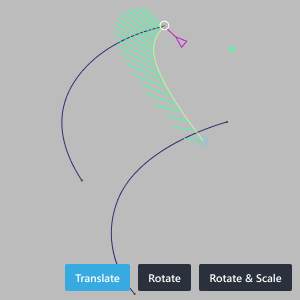 Transform Curve
Transform Curve
Provides a direct way of positioning a curve so that it intersects two rail curves.
Positioning and intersecting a curve can be done in two ways:
- By moving the curve so that it intersects the first rail, then “rocking” (rotating) it so that it intersects the second rail.
- By “dilating” (scaling) the curve, while preserving its shape characteristics, so that it intersects both rails. This is different from the Stretch
 tool, which changes the curvature characteristics of the curve as it stretches it.
tool, which changes the curvature characteristics of the curve as it stretches it.
Access this tool from the Curve Edit tool palette:

Curve Transform Options
Transform type
Determines what mode the tool starts in. Choices are Translate, Rotate, Rotate & Scale. The default is Translate.
Transform Curve workflows
Method 1: Translating and Rotating a curve (rocking)
Select the Transform Curve tool:
 .
.Select the curve.
Two control handles (circles) appear at the start and end points of the selected curve.
Note: You can move the control handles along the curve by clicking on them and dragging the small purple arrow along the curve.Click on the Translate button in the window.
Select the control handle closest to the first rail.
The selected handle turns white.
Turn on Curve snap mode by holding down the
CtrlandAltkeys or Magnet mode by holding downCtrl.Click on the first rail curve. Drag to change the position of the intersection.

The input curve is translated so that the first control handle intersects the first rail.
Click on the Rotate button in the window.
The second control handle turns white. A manipulator appears at the location of the first control handle. This can be used to specify the plane of rotation: XY, YZ, XZ. By default, the curve rotates in its own plane.
Turn on Curve snap mode by holding down the
CtrlandAltkeys.Click on the second rail curve.

The input curve rotates in the specified plane of rotation, using the first intersection as its rotation pivot, so that it now intersects the second rail.
The shape of the curve does not change.
Method 2: Rotating and Scaling a curve (dilating)
Select the Transform Curve tool:
 .
.Select the curve.
Two control handles (circles) appear at the start and end points of the selected curve.
Note: You can move the control handles along the curve by clicking on them and dragging the small purple arrow along the curve.
Click on the Rotate & Scale button in the window.
Click on one control handle.
The selected handle turns white.
Turn on Curve snap mode by holding down the
CtrlandAltkeys (or Magnet mode by holding downCtrlonly).Click on the rail curve you want to snap the selected handle to.
Repeat steps 4 to 6 with the other control handle.

The input curve is scaled so that both control handles make contact with the target points on the rail curves.
The curve is modified, but the general shape characteristics are maintained, as can be verified by using a curvature comb on the curve (Locators > Curve Curvature
 ).
).
How do I use the rotation manipulator?
The rotation manipulator appears when you are in Rotate mode (Rotate button depressed). It has three axes (X, Y and Z), and a circle along which the selected handle on the curve rotates. By default, this circle is drawn in the plane of the curve.

Click on one of the three axes to change the plane of rotation to the plane perpendicular to that axis.
The circle is redrawn in that plane.
Note: Currently, the only way to go back to using the plane of the curve as plane of rotation is to re-enter the tool, click the curve and then click the Rotate button again.